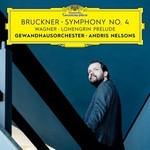|
Back
03/20/2018
Anton Bruckner: Symphony n° 4 in E-flat Major, “Romantic”
Richard Wagner: Lohengrin: Prelude to Act I
Gewandhausorchester Leipzig, Andris Nelsons (conductor)
Recording: Gewandhaus zu Leipzig (May 2017) – 79’24
Deutsche Grammophon 479 7477 – Booklet in English, German, French

   
This is the second disc in a new Deutsche Grammophon project featuring pairings of Wagner and Bruckner under the baton of Andris Nelsons. With the Gewandhausorchester in splendid, sonorous sound, the decision to purchase simply comes down to one’s opinion of Nelsons’ idiosyncratic conducting.
Nelsons seems keen on dissecting the score, presenting it as a series of juxtaposed musical events, each with their own profile, which are then meant to present a mammoth, epic picture. Bruckner’s music allows for this, but previous prominent Brucknerians (Klemperer, Karajan, Blomstedt) strove for continuity and organic unfolding of the music. Nelsons’ approach might not be for all tastes, but it is certainly different, and in many ways, more contemporary.
Some of the oddities aren’t immediately apparent. The opening horn call and first crescendo sound similar to most other recordings, but once the orchestra starts passing around the motivic material, Nelsons purposefully lets seams show. This lets us appreciate the two-against-three polyrhythms that dominate the music, but at cadential moments there is often an ungainly gap that seems to defeat the very purpose of harmonic closure. This is especially apparent at the ends of the first, third, and fourth movements.
The contrasting moods and tempi of the middle two movements are exaggerated. The “Andante” isn’t anywhere near being quasi Allegretto, as Bruckner indicated. While the playing is beautiful, this movement suffers the most from sluggishness and separation. The “Scherzo”, on the other hand, is crisp and accurate, galloping along with brass fanfares braying gloriously. The “Trio” is more controversial. Again, Bruckner indicates keinesfalls schleppend (“not sluggish at all”), but Nelsons’ consistent use of rubato at an already rather slow tempo ends up feeling, well, sluggish.
Dorothea Walchshäusl’s liner notes, featuring quotes from an apparent interview with Nelsons, points up the “mysticism” Wagner and Bruckner shared (albeit from different angles.) Thus, by pairing this particular Bruckner symphony with Wagner’s Lohengrin “Prelude”, the aim seems to be to show a connection (through “religious elements” - whatever that means) between absolute and and program music. It’s a heavy-handed, perhaps unnecessary connection—there aren’t many that would argue that Wagner had no musical influence on Bruckner. That said, Nelsons’ microscopic approach fares better overall in the Wagner “Prelude”, which again features some ravishing sonorities from the strings and brass, almost as if encapsulating Bruckner’s entire symphony in a mere nine minutes.
As with any new Bruckner release, one immediately questions if the investment is necessary. I’d wager that Nelsons’ interpretive stance produces a different enough vision of this oft-recorded symphony that Bruckner devotees will find it provocative, and either passionately love or hate it. For me, the jury is still out.
Marcus Karl Maroney
|